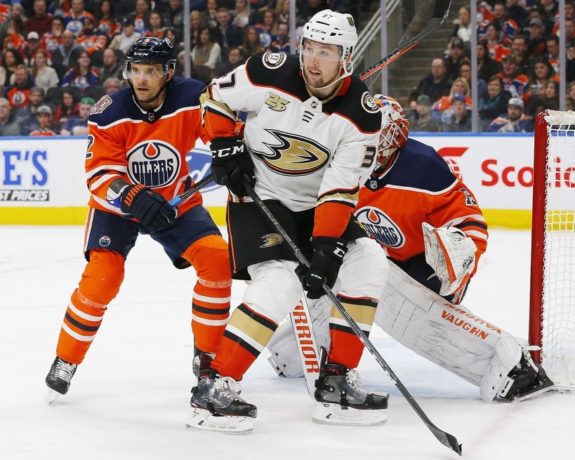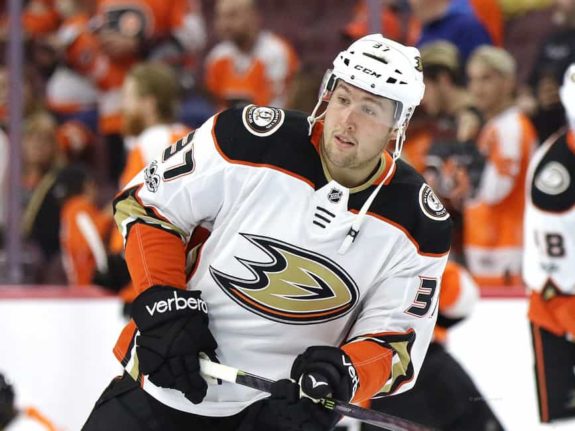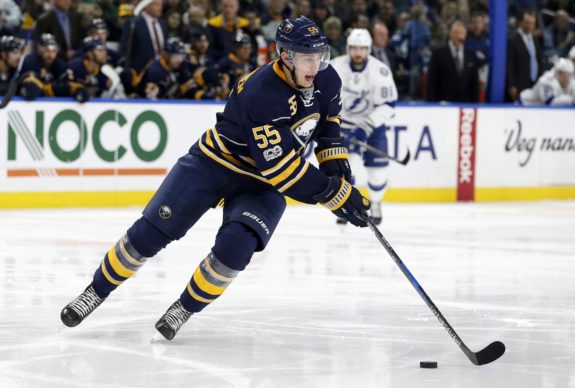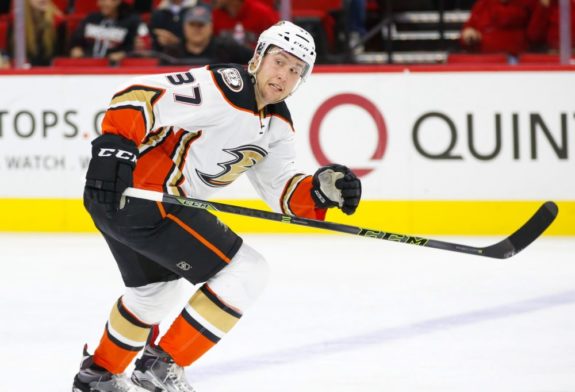Approaching the start of the 2019-20 Anaheim Ducks season, there is one familiar question concerning one particular Ducks player. What to do with Nick Ritchie? The answer is to trade him. However, for a team in the middle of at least a short rebuild, you might think trading Ritchie should involve prospects on the way back, not so fast. The best trade involving Ritchie would be the “change of scenery trade,” and there are plenty of examples to make this point.
Ritchie Is This Decade’s Benoit Pouliot
Ritchie and Benoit Pouliot’s careers have had a lot in common. Both were tall, talented left wings with elite shots and excellent offensive instincts coming out of major-junior. However, both failed to live up to expectations while gaining a reputation for lacking discipline along the way.
Not that either player is or was a failure in their NHL. Pouliot, who last played in 2017-18 and is a free agent, played 12 seasons in the NHL topping 15 goals on four occasions and amassing at least 30 points five times.
Four seasons into his NHL career, Ritchie is in the same boat. Drafted No. 10 overall by the Ducks in 2014, expectations for the big-bodied left-winger were high after four dominating seasons in the OHL with the Peterborough Petes and the Sault Ste. Marie Greyhounds.

With a crop of talented young forwards ready to push for permanent roster spots, Ritchie’s inability to cement himself as an elite NHL forward rather than a decent middle-six player has partially caused the uncertainty about his future with the Ducks.
Like Pouliot Did, Ritchie Still Has Value
After three seasons where Pouliot could not establish himself in the NHL, the Wild traded him to the Montreal Canadiens for right-winger Guillaume Latendresse. After the early-season 2009 trade, Wild general manager (GM) at the time, Chuck Fletcher said, “Probably both players will benefit from a change of scenery.”
After the trade Latendresse exploded for 25 goals and 12 assists in 55 games for the Wild while Pouliot had a career-high 15 goals and nine assists in 39 games for Montreal.
It’s time for GM Bob Murray and the Ducks to give Ritchie that change of scenery. Though he’s been productive in his time with Anaheim, there are a couple of players coming along that could benefit from more time in the lineup if the Ducks trade Ritchie. Max Comtois and Max Jones come to mind.
His contract is favorable, carrying a cap hit of about $1.5 million for the next two seasons for a player who has produced around 30 points per season.
The best-case scenario for a trade partner is a GM who thinks Ritchie could still tap into his potential on top of the moderate production he’s already capable of. In return, the Ducks would receive their own talented yet struggling player who may need a new lease on their hockey life.

Though “change of scenery” trades of late have tended to involve two players with comparable salaries and similar positions like the recent James Neal for Milan Lucic trade, or last fall’s Max Domi for Alex Galchenyuk swap, there’s no reason to think the Ducks can’t trade Ritchie for an established right-handed defenseman.
A Finn on the Way out with the Sabres?
Buffalo Sabres’ Rasmus Ristolainen would be the best fit, and the rumor mill is churning. It looks like the Finnish defenseman wants to get out of Buffalo telling MTV Sport in Finland that he “Hasn’t been able to enjoy hockey.”
Could playing for a new team benefit Ristolainen and make him enjoy the sport again? Certainly, living in Southern California versus Buffalo would help.
A player’s happiness isn’t the decider of whether he’s worth trading for, but Ristolainen still hsa a lot of potential. He’s a right-handed defender, a significant need for the Ducks. He’s put up more than 40 points per season since 2015-16. His 43 points last season would’ve led Ducks defensemen by 15 points.
Though he had a down year on the power play last season, he’s been a reliable distributor in the past with the man advantage. After one of their worst offensive seasons in franchise history, the Ducks need as much punch in the opponent’s end as possible.
He does have a reputation as a defensive-zone liability, which is something the Ducks struggled with last season as they averaged 33.2 shots against per game, the seventh-worst mark in the league.
Still, Ristolainen played in front of mediocre goaltending at best during his time in Buffalo. Until last season, when Rasmus Dahlin arrived, he hasn’t had the luxury of a defensive partner quite to the level of Cam Fowler or Hampus Lindholm either.

Ristolainen might find new life on the Ducks’ second defensive pairing with Fowler or Lindholm on his left, and perhaps a fresh start will help him develop his defensive game. If the Sabres agree to retain at least part of his salary, even better.
Ritchie’s Fit in Buffalo
Going back the other way, Ritchie might fit in with the Sabres more than you would think.
Yes, they are pretty deep at left wing with the additions of Marcus Johansson and Jimmy Vesey this offseason and Jeff Skinner firmly established as a star in that spot.
That’s where Ritchie’s contract comes in. With a $1.5 million cap hit for two more seasons, trading that contract for Ristolainen’s cap hit of $5.4 million helps the Sabres. As of right now, they are already projected to have to use long-term injured reserve relief to stay under the salary cap.
It’s not out of the question for Buffalo to let Ritchie push Vesey and Johansson for a second or third-line role. If he continues to produce at the current rate, they’ve got a strong third or even fourth-line player, if he breaks out, all the better for the Sabres.

Though he’s been a capable NHL player with the Ducks and has put up numbers, Ritchie hasn’t lived up to the expectations of a high first-round pick. The Ducks are in a position where they can use his favorable contract and still-untapped potential to entice a trade partner that could fill their need for a right-shot defenseman.